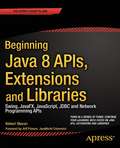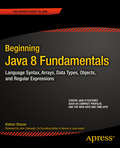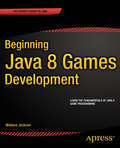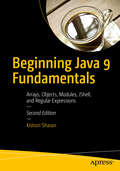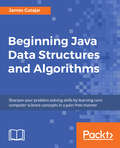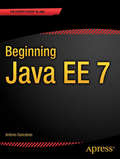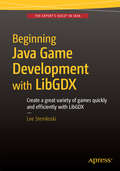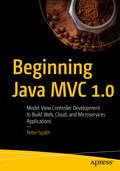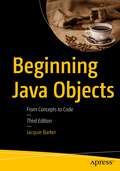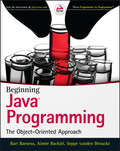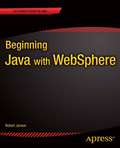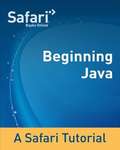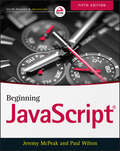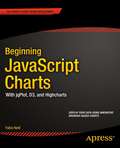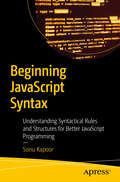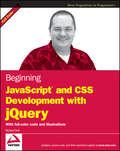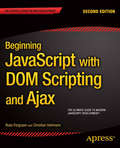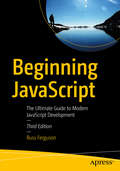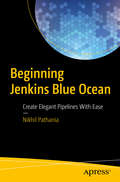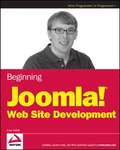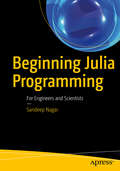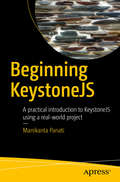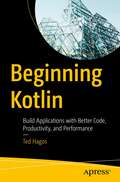- Table View
- List View
Beginning Java 8 APIs, Extensions and Libraries: Swing, JavaFX, JavaScript, JDBC and Network Programming APIs
by Kishori SharanBeginning Java 8 APIs, Extensions and Libraries completes the Apress Java learning journey and is a comprehensive approach to learning the Java Swing, JavaFX, Java Scripting, JDBC and network programming APIs. This book covers the key extesnsions of the Java programming language such as Swing, JavaFX, network programming, and JDBC. Each topic starts with a discussion of the topic's background. A step-by-step process, with small snippets of Java code, provides easy-to-follow instructions. At the end of a topic, a complete and ready-to-run Java program is provided. This book contains over 130 images and diagrams to help you visualize and better understand the topics. More than 130 complete programs allow you to practice and quickly learn the topics. The Swing chapters discuss various aspects of working with a GUI, from the very basic concepts of developing a Swing application, to the most advanced topics, such as decorating a Swing component with a JLayer, drag-and-drop features, Synth Skinnable L&F, etc. The chapter on network programming covers the basics of network technologies first, and then, the advanced topics of network programming, using a Java class library. It covers IPv4 and IPv6, addressing schemes, subnetting, supernetting, multicasting, TCP/IP sockets, UPD sockets, asynchronous socket I/O, etc. The chapter on JDBC provides the details of connecting and working with databases such as Oracle, SQL Server, MySQL, DB2, Java DB (Apache Derby), Sybase, Adaptive Server Anywhere, etc. It contains a complete discussion on processing a ResultSet and a RowSet. It discusses how to use the RowSetFactory, to obtain a RowSet object of a specific type. Working with Large Objects (LOBs), such as Blob, Clob, and NClob, is covered in detail with Java code examples and database scripts.
Beginning Java 8 Fundamentals: Language Syntax, Arrays, Data Types, Objects, and Regular Expressions
by Kishori SharanBeginning Java 8 Fundamentals provides a comprehensive approach to learning the Java programming language, especially the object-oriented fundamentals necessary at all levels of Java development. Author Kishori Sharan provides over 90 diagrams and 240 complete programs to help beginners and intermediate level programmers learn the topics faster. Starting with basic programming concepts, the author walks you through writing your first Java program step-by-step. Armed with that practical experience, you'll be ready to learn the core of the Java language. The book continues with a series of foundation topics, including using data types, working with operators, and writing statements in Java. These basics lead onto the heart of the Java language: object-oriented programming. By learning topics such as classes, objects, interfaces, and inheritance you'll have a good understanding of Java's object-oriented model. The final collection of topics takes what you've learned and turns you into a real Java programmer. You'll see how to take the power of object-oriented programming and write programs that can handle errors and exceptions, process strings and dates, format data, and work with arrays to manipulate data. What you'll learn How to write your first Java programs with an emphasis on learning object-oriented programming in Java What are data types, operators, statements, classes and objects How to do exception handling, assertions, strings and dates, and object formatting What are regular expressions and how to use them How to work with arrays, interfaces, enums, and inheritance How to deploy Java applications on memory-constrained devices using compact profiles Who this book is for This book is for those who are new to Java programming, who may have some or even no prior programming experience. Table of Contents 1. Programming Concepts 2. Writing Java Programs 3. Data Types 4. Operators 5. Statements 6. Classes and Objects 7. Object and Objects Classes 8. Wrapper Classes 9. Exception Handling 10. Assertions 11. Strings 12. Dates and Times 13. Formatting Data 14. Regular Expressions 15. Arrays 16. Inheritance 17. Interfaces 18. Enum Types 19. ASCII Character Set 20. Writing Documentation Comments 21. Compact Profiles
Beginning Java 8 Games Development
by Wallace JacksonBeginning Java 8 Games Development, written by Java expert and author Wallace Jackson, teaches you the fundamentals of building a highly illustrative game using the Java 8 programming language. In this book, you'll employ open source software as tools to help you quickly and efficiently build your Java game applications. You'll learn how to utilize vector and bit-wise graphics; create sprites and sprite animations; handle events; process inputs; create and insert multimedia and audio files; and more. Furthermore, you'll learn about JavaFX 8, now integrated into Java 8 and which gives you additional APIs that will make your game application more fun and dynamic as well as give it a smaller foot-print; so, your game application can run on your PC, mobile and embedded devices. After reading and using this tutorial, you'll come away with a cool Java-based 2D game application template that you can re-use and apply to your own game making ambitions or for fun. What you'll learn How to develop games using Java 8 How to employ vector-based graphics or bitmap graphics How to create your 2D game sprites How to animate those game sprites How to handle events to process player input How to optimize and implement digital audio assets Who this book is for This book is for game developers with little experience using Java, little experience in developing games, or both. Table of Contents 1. Setting Up a Java 8 Game Development Environment 2. Setting Up Your Java 8 IDE 3. A Java 8 Primer 4. An Introduction to JavaFX 8 5. An Introduction to Game Design 6. The Foundation of Game Design 7. The Foundation of Game Play Loop 8. Creating Your Actor Engine 9. Controlling Your Action Figure 10. Directing the Cast of Actors 11. Moving Your Action Figure in 2D 12. Setting Boundaries for Your Action Figure in 2D 13. Animating Your Action Figure States 14. Setting Up the Game Environment 15. Implementing Game Audio Assets 16. Collision Detection 17. Enhancing Game Play
Beginning Java 8 Language Features: Lambda Expressions, Inner Classes, Threads, I/O, Collections, and Streams
by Kishori SharanBeginning Java 8 Language Features covers essential and advanced features of the Java programming language such as the new lambda expressions (closures), inner classes, threads, I/O, Collections, garbage collection, streams, and more. Author Kishori Sharan provides over 60 diagrams and 290 complete programs to help you visualize and better understand the topics covered in this book. The book starts with a series of chapters on the essential language features provided by Java, including annotations, inner classes, reflection, and generics. These topics are then complemented by details of how to use lambda expressions, allowing you to build powerful and efficient Java programs. The chapter on threads follows this up and discusses everything from the very basic concepts of a thread to the most advanced topics such as synchronizers, the fork/join framework, and atomic variables. This book contains unmatched coverage of Java I/O, including NIO 2. 0, the Path API, the FileVisitor API, the watch service and asynchronous file I/O. With this in-depth knowledge, your data- and file-management programs will be able to take advantage of every feature of Java's powerful I/O framework. Finally, you'll learn how to use the Stream API, a new, exciting addition to Java 8, to perform aggregate operations on collections of data elements using functional-style programming. You'll examine the details of stream processing such as creating streams from different data sources, learning the difference between sequential and parallel streams, applying the filter-map-reduce pattern, and dealing with optional values.
Beginning Java 9 Fundamentals: Arrays, Objects, Modules, JShell, and Regular Expressions
by Kishori SharanLearn the basics of Java 9, including basic programming concepts and the object-oriented fundamentals necessary at all levels of Java development. Author Kishori Sharan walks you through writing your first Java program step-by-step. Armed with that practical experience, you'll be ready to learn the core of the Java language. Beginning Java 9 Fundamentals provides over 90 diagrams and 240 complete programs to help you learn the topics faster. The book continues with a series of foundation topics, including using data types, working with operators, and writing statements in Java. These basics lead onto the heart of the Java language: object-oriented programming. By learning topics such as classes, objects, interfaces, and inheritance you'll have a good understanding of Java's object-oriented model. The final collection of topics takes what you've learned and turns you into a real Java programmer. You'll see how to take the power of object-oriented programming and write programs that can handle errors and exceptions, process strings and dates, format data, and work with arrays to manipulate data. This book is a companion to two other books also by Sharan focusing on APIs and advanced Java topics. What You'll Learn Write your first Java programs with an emphasis on learning object-oriented programming in Java Work with data types, operators, statements, classes and objects Handle exceptions, assertions, strings and dates, and object formatting Use regular expressions Work with arrays, interfaces, enums, and inheritance Deploy Java applications on memory-constrained devices using compact profiles Take advantage of the new JShell REPL tool Who This Book Is For Those who are new to Java programming, who may have some or even no prior programming experience.
Beginning Java Data Structures and Algorithms: Sharpen your problem solving skills by learning core computer science concepts in a pain-free manner
by James CutajarThough your application serves its purpose, it might not be a high performer. Learn techniques to accurately predict code efficiency, easily dismiss inefficient solutions, and improve the performance of your application.Key FeaturesExplains in detail different algorithms and data structures with sample problems and Java implementations where appropriateIncludes interesting tips and tricks that enable you to efficiently use algorithms and data structuresCovers over 20 topics using 15 practical activities and exercises Book DescriptionLearning about data structures and algorithms gives you a better insight on how to solve common programming problems. Most of the problems faced everyday by programmers have been solved, tried, and tested. By knowing how these solutions work, you can ensure that you choose the right tool when you face these problems.This book teaches you tools that you can use to build efficient applications. It starts with an introduction to algorithms and big O notation, later explains bubble, merge, quicksort, and other popular programming patterns. You’ll also learn about data structures such as binary trees, hash tables, and graphs. The book progresses to advanced concepts, such as algorithm design paradigms and graph theory. By the end of the book, you will know how to correctly implement common algorithms and data structures within your applications.What you will learnUnderstand some of the fundamental concepts behind key algorithmsExpress space and time complexities using Big O notation.Correctly implement classic sorting algorithms such as merge and quicksortCorrectly implement basic and complex data structuresLearn about different algorithm design paradigms, such as greedy, divide and conquer, and dynamic programmingApply powerful string matching techniques and optimize your application logicMaster graph representations and learn about different graph algorithmsWho this book is forIf you want to better understand common data structures and algorithms by following code examples in Java and improve your application efficiency, then this is the book for you. It helps to have basic knowledge of Java, mathematics and object-oriented programming techniques.
Beginning Java EE 7
by Antonio GoncalvesJava Enterprise Edition (Java EE) continues to be one of the leading Java technologies and platforms. Beginning Java EE 7 is the first tutorial book on Java EE 7. Step by step and easy to follow, this book describes many of the Java EE 7 specifications and reference implementations, and shows them in action using practical examples. This definitive book also uses the newest version of GlassFish to deploy and administer the code examples. Written by an expert member of the Java EE specification request and review board in the Java Community Process (JCP), this book contains the best information possible, from an expert's perspective on enterprise Java technologies.
Beginning Java Game Development with LibGDX
by Lee StemkoskiDesign and create video games using Java, with the LibGDX software library. By reading Beginning Java Game Development with LibGDX, you will learn how to design video game programs and how to build them in Java. You will be able to create your own 2D games, using various hardware for input (keyboard/mouse, gamepad controllers, or touchscreen), and create executable versions of your games. The LibGDX library facilitates the game development process by providing pre-built functionality for common tasks. It is a free, open source library that includes full cross-platform compatibility, so programs written using this library can be compiled to run on desktop computers (Windows/MacOS), web browsers, and smartphones/tablets (both Android and iOS). Beginning Java Game Development with LibGDX teaches by example with many game case study projects that you will build throughout the book. This ensures that you will see all of the APIs that are encountered in the book in action and learn to incorporate them into your own projects. The book also focuses on teaching core Java programming concepts and applying them to game development. What you'll learn How to use the LibGDX framework to create a host of 2D arcade game case studies How to compile your game to run on multiple platforms, such as iOS, Android, Windows, and MacOS How to incorporate different control schemes, such as touchscreen, gamepad, and keyboard Who this book is for You should have an introductory level knowledge of basic Java programming. In particular, you should be familiar with: variables, conditional statements, loops, and be able to write methods and classes to accomplish simple tasks. This background is equivalent to having taken a first-semester college course in Java programming. Examples of intermediate-level Java topics that you will learn from this book include: data structures (lists, iterators, and dictionaries), exception handling, abstract classes, inner classes, and event-driven programming. You will also see software engineering practices in context, such as code refactoring, iterative development, and the creation of debugging features. Table of Contents 1. Getting Started with Java and LibGDX 2. Using the LibGDX Framework 3. Extending the LibGDX Framework 4. Audio and Resource Management 5. Advanced UI Design 6. Alternative Forms of Input 7. Integrating Third-Party Software 8. Introduction to 3D Programming 9. Taking Your Games Further Appendix A: Summary of Java Concepts Needed for This Book
Beginning Java MVC 1.0: Model View Controller Development to Build Web, Cloud, and Microservices Applications
by Peter SpäthGet started with using the new Java MVC 1.0 framework for model, view, and controller development for building modern Java-based web, native, and microservices applications. Beginning Java MVC teaches you the basics, then dives in to models, views, controllers. Next, you learn data binding, events, application types, view engines, and more. You will be given practical examples along the way to reinforce what you have learned. Furthermore, you'll work with annotations, internationalization, security, and deployment. After reading this book, you'll have the know how to build your first full Java-based MVC application. What You Will Learn Discover the Java MVC 1.0 APIs and how to use them Master the Model, View and Controller design pattern Carry out data binding Write events Work with view engines Who This Book Is For Those new to Java MVC 1.0. Some prior experience with Java programming recommended, especially with JSF or Struts.
Beginning Java Objects: From Concepts to Code
by Jacquie BarkerExport author Barker covers information key for proficiency with an OO programming language like Java, and shows how to really create reusable code and extensible applications.
Beginning Java Programming: The Object Oriented Approach
by Bart Baesens Seppe Vanden Broucke Aimee BackielA comprehensive Java guide, with samples, exercises, case studies, and step-by-step instruction Beginning Java Programming: The Object Oriented Approach is a straightforward resource for getting started with one of the world's most enduringly popular programming languages. Based on classes taught by the authors, the book starts with the basics and gradually builds into more advanced concepts. The approach utilizes an integrated development environment that allows readers to immediately apply what they learn, and includes step-by-step instruction with plenty of sample programs. Each chapter contains exercises based on real-world business and educational scenarios, and the final chapter uses case studies to combine several concepts and put readers' new skills to the test. Beginning Java Programming: The Object Oriented Approach provides both the information and the tools beginners need to develop Java skills, from the general concepts of object-oriented programming. Learn to: Understand the Java language and object-oriented concept implementation Use Java to access and manipulate external data Make applications accessible to users with GUIs Streamline workflow with object-oriented patterns The book is geared for those who want to use Java in an applied environment while learning at the same time. Useful as either a course text or a stand-alone self-study program, Beginning Java Programming is a thorough, comprehensive guide.
Beginning Java with WebSphere
by Robert W JansonBeginning Java with WebSphere provides a step-by-step guide for creating and installing both client- and server-based Java applications using Rapid Application Development v8, WebSphere Application Server 8. 0, and Java. Since more and more Java applications are moving to the server and using HTML for the user interface, there is a minimal amount of time spent exploring the Java GUI components. More specifically, this book covers graphical user interfaces using RAD's Visual Editor, variables, conditional logic, and application improvements/enhancements from the client side. And, from the server-side, this book covers servlets, JavaServer Pages (JSPs), database accessibility (JDBC), custom tags, and concludes with JavaServer Faces (JSFs). This book concentrate on base topics that allow you to get to the server-side and database topics quickly.
Beginning Java: A Safari Tutorial
by Safari Content TeamThis is the first of a 3 part series of tutorials to learn Java Skills in Safari Books Online. This beginning Java tutorial is designed for individuals that may not have development experience, or developers who have had non-Java development experience, such as Cobol programming. Developing applications with Java uses an object-oriented programming (OOP) approach, and relies heavily upon the OOP paradigm to describe and use the functionality of the language. Key concepts such as inheritance, objects, classes and the heavy typing used to declare variables and their contents are not optional, but they are instead required elements of the language. Follow along in this tutorial to learn about all of these beginning Java skills in Safari Books Online.
Beginning JavaScript
by Paul Wilton Jeremy McpeakThe perennial bestseller returns with new details for using the latest tools and techniques available with JavaScriptJavaScript is the definitive language for making the Web a dynamic, rich, interactive medium. This guide to JavaScript builds on the success of previous editions and introduces you to many new advances in JavaScript development. The reorganization of the chapters helps streamline your learning process while new examples provide you with updated JavaScript programming techniques.You'll get all-new coverage of Ajax for remote scripting, JavaScript frameworks, JavaScript and XML, and the latest features in modern Web browsers. Plus, all the featured code has been updated to ensure compliance with the most recent popular Web browsers.Introduces you to the latest capabilities of JavaScript, the definitive language for developing dynamic, rich, interactive Web sitesFeatures new coverage of data types and variables, JavaScript and XML, Ajax for remote scripting, and popular JavaScript frameworksOffers updated code that ensures compliance with the most popular Web browsersIncludes improved examples on the most up-to-date JavaScript programming techniquesContinuing in the superlative tradition of the first three editions, Beginning JavaScript, Fourth Edition, gets you up to speed on all the new advances in JavaScript development.Note: CD-ROM/DVD and other supplementary materials are not included as part of eBook file.
Beginning JavaScript
by Jeremy McpeakThe bestselling JavaScript guide, updated with current features and best practices Beginning JavaScript 5th Edition shows you how to work effectively with JavaScript frameworks, functions, and modern browsers, and teaches more effective coding practices using HTML5. This new edition has been extensively updated to reflect the way JavaScript is most commonly used today, introducing you to the latest tools and techniques available to JavaScript developers. Coverage includes modern coding practices using HTML5 markup, the JSON data format, DOM APIs, the jQuery framework, and more. Exercises with solutions provide plenty of opportunity to practice, and the companion website offers downloadable code for all examples given in the book. Learn JavaScript using the most up to date coding style Understand JSON, functions, events, and feature detection Utilize the new HTML5 elements and the related API Explore new features including geolocation, local storage, and more JavaScript has shaped the Web from a passive medium into one that is rich, dynamic, and interactive. No matter the technology on the server side, it's JavaScript that makes it come alive in the browser. To learn JavaScript the way it's used today, Beginning JavaScript, 5th Edition is your concise guide.
Beginning JavaScript Charts: With jqPlot, d3, and Highcharts
by Fabio NelliBeginning JavaScript Charts shows how to convert your data into eye-catching, innovative, animated, and highly interactive browser-based charts. This book is suitable for developers of all experience levels and needs: for those who love fast and effective solutions, you can use the jqPlot library to generate charts with amazing effects and animations using only a few lines of code; if you want more power and need to create data visualization beyond traditional charts, then D3 is the JavaScript library for you; finally, if you need a high-performance, professional solution for interactive charts, then the Highcharts library is also covered. If you are an experienced developer and want to take things further, then Beginning JavaScript Charts also shows you how to develop your own graphics library starting from scratch using jQuery. At the end of the book, you will have a good knowledge of all the elements needed to manage data from every possible source, from high-end scientific instruments to Arduino boards, from PHP SQL databases queries to simple HTML tables, and from Matlab calculations to reports in Excel. You will be able to provide cutting-edge charts exploiting the growing power of modern browsers. Create all kinds of charts using the latest technologies available on browsers (HTML5, CSS3, jQuery, jqPlot, D3, Highcharts, and SVG) Full of step-by-step examples, Beginning JavaScript Charts introduces you gradually to all aspects of chart development, from the data source to the choice of which solution to apply. This book provides a number of tools that can be the starting point for any project requiring graphical representations of data, whether using commercial libraries or your own What you'll learn Learn the jqPlot, D3, Highcharts, CSS, jQuery and SVG basics. Discover the world of JavaScript graphic libraries. Discover which charts can best represent your data. Switch from a vision of a chart sent from a server as a static image to a highly dynamic one, in which the user is able to interact in real time. Perform input data manipulation to increase chart readability. Develop your own graphic library. Who this book is for Beginning JavaScript Charts is for developers at all levels interested in data visualization, and ready to embrace modern web standards and animate and display their data with powerful, cutting-edge technologies. Table of Contents Charting Technology Overview jQuery Basics Simple HTML Tables Drawing a Line Chart Drawing a Bar Chart Drawing a Pie Chart Creating a Library for Simple Charts Introducing jqPlot Line Charts with jqPlot Bar Charts with jqPlot Pie Charts with jqPlot Candlestick Charts with jqPlot Bubble Charts with jqPlot Other Charts with jqPlot Adding Controls to Charts Embedding jqPlot Charts in jQuery Widgets Handling Input Data Moving from jqPlot to Highcharts Introducing D3 Line Charts with D3 Bar Charts with D3 Pie Charts with D3 Candlestick Charts with D3 Scatterplot and Bubble Charts with D3 Radar Charts with D3 Handling Live Data with D3 App A: Guidelines for the Examples in the Book App B: jqPlot Plugins
Beginning JavaScript Syntax: Understanding Syntactical Rules and Structures for Better JavaScript Programming
by Sonu KapoorThis book is a practical and beginner-friendly guide that focuses exclusively on the syntax of JavaScript, the most widely-used programming language for web development today. Designed to be a clear and accessible introduction for new learners, this book will teach you the essential syntax rules and constructs of JavaScript in a structured, easy-to-understand format. With the explosive growth of web applications and the continued dominance of JavaScript in frameworks like Angular, React, and Node.js, learning JavaScript has never been more relevant. For those starting out in web development, this book will provide the essential foundation needed to build more advanced skills. While other beginner guides may try to cover too much too quickly, this book deliberately focuses on core syntax, so you build a solid understanding from the ground up. Understanding syntax is the first step toward becoming a proficient programmer. JavaScript, in particular, is a flexible yet quirky language with its own unique syntax and conventions. For beginners, this can be overwhelming, but this book demystifies the language&’s structure and explains how to use JavaScript's syntax to write effective and efficient code. Mastery of syntax is critical for writing clean, readable code, and for avoiding common programming errors. The book covers a range of foundational topics, from understanding basic syntax elements like variables, operators, and data types, to mastering control flow with conditionals and loops, and working with more complex structures like functions, objects, and arrays. It also introduces the modern ES6+ syntax features that are now standard in most JavaScript projects, such as arrow functions, destructuring, and template literals. By the end of this book, you will not only have a strong grasp of JavaScript&’s syntax, but also the confidence to write, debug, and maintain your own JavaScript code effectively. Whether you&’re an aspiring developer or someone looking to solidify their understanding of JavaScript&’s building blocks, this book will serve as a valuable resource in your journey. You Will Learn: How to use JavaScript&’s core syntax elements, including variables, data types, operators, control flow (conditionals and loops), and functions. Techniques to debug common JavaScript errors and write clean, readable code How to use key ES6+ syntax features such as arrow functions, template literals, destructuring assignments, and the spread/rest operators How to manipulate the DOM, handle user interactions, and manage data This book is for: Web developers, students, or professionals transitioning into the tech industry
Beginning JavaScript and CSS Development with jQuery
by Richard YorkThis book covers the jQuery JavaScript framework and the jQuery UI JavaScript framework to get more results faster out of JavaScript programming. The author covers each method exposed by jQuerys API, which contains methods to resolve common, redundant tasks in less code. You will also learn how jQuery eliminates certain cross-browser, cross-platform development headaches like the event model. In addition to giving you the ability to simulate events, this book also helps simplify your work with events by reducing the amount of code that you need to write to attach events.
Beginning JavaScript with DOM Scripting and Ajax: Second Editon (Beginning: From Novice To Professional Ser.)
by Christian Heilmann Russ FergusonBeginning JavaScript with DOM Scripting and Ajax is an essential resource for modern JavaScript programming. This completely updated second edition covers everything you need to know to get up-to-speed with JavaScript development and add dynamic enhancements to web pages, right from the basics. As well as focusing on client-side JavaScript, you will also learn how to work with the Browser Object Model, the Document Object Model (DOM), how to use XML and JSON as well as communicate with service side scripts such as PHP. Find out how to: Construct good JavaScript syntax following modern coding practices Use JavaScript to communicate with the server and retrieve data Dynamically manipulate markup, validate forms and deal with images Debug applications using features inside the browser JavaScript is one of the most important technologies on the web. It provides the means to add dynamic functionality to your web pages and serves as the backbone of Ajax-style web development. Beginning JavaScript with DOM Scripting and Ajax will take you from being a JavaScript novice to work freely with this important technology - begin your JavaScript journey today!
Beginning JavaScript: The Ultimate Guide to Modern JavaScript Development
by Russ FergusonDiscover everything you need to know to get up-to-speed with JavaScript development and add dynamic enhancements to web pages. This completely updated third edition reveals how the code works and when to use closures, constants, and execution content. <p><p> Starting with the basics, you’ll see how to employ prototypical inheritance, as well as memory management, variable hoisting and event bubbling. Also covered is an introduction to Node.js and package managers, key to understanding the tools necessary in front-end development and how they are used with current JavaScript frameworks. <p><p> JavaScript is one of the most important technologies on the web, providing the means to add dynamic functionality to your web pages and serving as the backbone of working with frameworks like Angular and React. Beginning JavaScript, Third Edition will take you from being a JavaScript novice to working freely with this important technology - begin your JavaScript journey today! What You'll LearnConstruct good JavaScript syntax following modern coding practicesUse JavaScript to communicate with the server and retrieve dataDynamically manipulate markup, validate forms and deal with imagesDebug applications using features inside the browserUse TypeScript to bring strong typing to the languageWho This Book Is For Beginner to intermediate developers with a basic knowledge of front-end programming who are looking for a deeper understanding of how JavaScript works in the browser and how to answer questions in an interview. <P><P><i>Advisory: Bookshare has learned that this book offers only partial accessibility. We have kept it in the collection because it is useful for some of our members. Benetech is actively working on projects to improve accessibility issues such as these.</i>
Beginning Jenkins Blue Ocean: Create Elegant Pipelines With Ease
by Nikhil PathaniaDive deep into Jenkins Blue Ocean and discover how easy creating a pipeline can be. You’ll see how Blue Ocean provides a better user experience when designing, running, and visualizing pipelines. This book shows you its intuitive user interface and its powerful pipeline editor and how this makes it a tool for everyone.Beginning Jenkins Blue Ocean starts with an introduction to Blue Ocean, followed by a step-by-step guide on how to set it up. You’ll learn how to create a pipeline for every branch and pull request on your Git, GitHub, and GitLab repositories. You'll experience the improved pipeline visualization and log diagnosis features in Blue Ocean. Later you will go beyond the visual pipeline editor to learn the declarative syntax and gain better control over your pipelines. Then, you'll take a look at some tools to enable you to write pipeline code in the declarative syntax. You will also learn to extend delivery pipelines with Jenkins shared libraries.What You Will LearnDiscover Jenkins Blue Ocean and how to use itCreate elegant pipelines using the visual pipeline editorWork with the declarative pipeline syntax Use tools that help you write declarative pipeline code Extend pipelines with Jenkins shared librariesVisualize pipelines from classic Jenkins in Blue OceanConfigure and view test results in Blue OceanAccurately diagnose pipeline failures using improved pipeline visualizationCreate multibranch pipeline projects for your Git, GitHub, and GitLab repositoriesWho This Book Is ForThose new to Jenkins who are looking for an easy introduction. The book will also be useful for readers familiar with classic Jenkins and would like to learn Jenkins Blue Ocean.
Beginning Joomla! Web Site Development
by Cory WebbBy programmers for programmers-the essential beginner's guide to building websites with Joomla! Want to build and maintain dynamic websites without having to learn HTML and CSS? Joomla! open-source web content management system and this beginner's guide are all you need. This book walks you step-by-step through the process of building a website with Joomla!, providing detailed instruction in Wrox's practical, programmer-to- programmer style. The book explores key concepts and shows how each concept relates to the development of an actual real-world web site you can access online. Joomla! is an open-source web content management system used to build and maintain dynamic web sites without using specific web languages like HTML and Cascading Style Sheets (CSS) Walks you step by step through the process of building a website with Jooma! and features plenty of examples of actual websites that illustrate concepts Topics include configuration; managing content, core modules, plugins, menus, and extensions; building custom templates; and performing troubleshooting; also provides advanced tips and tricks, and more From configuration and management to troubleshooting and advanced tips, this is the book to get you up and running with Joomla!
Beginning Julia Programming: For Engineers and Scientists
by Sandeep NagarGet started with Julia for engineering and numerical computing, especially data science, machine learning, and scientific computing applications. This book explains how Julia provides the functionality, ease-of-use and intuitive syntax of R, Python, MATLAB, SAS, or Stata combined with the speed, capacity, and performance of C, C++, or Java. You'll learn the OOP principles required to get you started, then how to do basic mathematics with Julia. Other core functionality of Julia that you'll cover, includes working with complex numbers, rational and irrational numbers, rings, and fields. Beginning Julia Programming takes you beyond these basics to harness Julia's powerful features for mathematical functions in Julia, arrays for matrix operations, plotting, and more. Along the way, you also learn how to manage strings, write functions, work with control flows, and carry out I/O to implement and leverage the mathematics needed for your data science and analysis projects. "Julia walks like Python and runs like C". This phrase explains why Julia is quickly growing as the most favored option for data analytics and numerical computation. After reading and using this book, you'll have the essential knowledge and skills to build your first Julia-based application. What You'll Learn Obtain core skills in Julia Apply Julia in engineering and science applications Work with mathematical functions in Julia Use arrays, strings, functions, control flow, and I/O in Julia Carry out plotting and display basic graphics Who This Book Is For Those who are new to Julia; experienced users may also find this helpful as a reference.
Beginning KeystoneJS: A practical introduction to KeystoneJS using a real-world project
by Manikanta PanatiLearn how to develop a complete and robust Node, express. js and MongoDB-based web application and mobile application backend quickly using KeystoneJS. You'll learn how KeystoneJS makes complicated things simple, without limiting the power or flexibility of node. js or the frameworks it is built on. Beginning KeystoneJS shows you how to build database-driven websites, applications, and APIs, all built upon Express, the defacto web server for Node. js that uses MongoDB as its storage backend. What You Will Learn Discover the setup and architecture of the KeystoneJS framework. See how easy it is to extend KeystoneJS Understand the custom types and fields provided out of the box Write clean markup and create templates using Swig Use the powerful editing options in the framework's responsive dashboard Who This Book Is For Technical and non-technical people who would like to build applications quickly to leverage structured data to improve productivity.
Beginning Kotlin: Build Applications with Better Code, Productivity, and Performance
by Ted HagosThis book introduces the Kotlin programming skills and techniques necessary for building applications. You'll learn how to migrate your Java programming skills to Kotlin, a Java Virtual Machine (JVM) programming language.The book starts with a quick tour of the Kotlin language and gradually walks you through the language in greater detail over the course of succeeding chapters. You’ll learn Kotlin fundamentals like generics, functional programming, type system, debugging, and unit testing. Additionally, with the book’s freely downloadable online appendices, you’ll discover how to use Kotlin for building Spring Boot applications, data persistence, and microservices. What You Will LearnLearn the Kotlin language, its functions, types, collections, generics, classes, and moreDive into higher-order functions, generics, debugging, and unit testingApply the fundamentals of Kotlin to Spring Boot Add Hibernate to your Spring Boot application for persistence and data accessibility Take advantage of functional programming available in KotlinWho This Book Is ForJava developers who are new to Kotlin and want to leverage Kotlin, particularly for building Spring Boot apps.
